Rob Cummings's Blog
August 2, 2014
Twenty one questions and a conversation with author Rob Cummings continued
Hello, this is Frank Dunn back again continuing our question session and conversation with Rob Cummings. I want to change things up a bit so let’s begin.
Question eleven: What are you working on now?
I’m currently editing my NANO book from 2013 titled Dual Sight. I hope to have it ready to publish before October of this year. This is my first attempt at writing a series. The remaining two books will be my NANO books for this year and next.
Question twelve: Isthere some of that work you could share with us?
Sure. I’d love to share.
Ten minutes into her drive, she was sitting on the shoulder of the road with a flat tire wondering who to call when a car pulled to a stop behind her. The headlights blazed white and penetrating into her car the intensity near blinding. The old Maria wouldn’t have even considered accepting help from a stranger, but when the guy got out of the car and made his way up beside her window, she began a focused deliberation. Dave’s words rang like a bell in her head. What could it hurt just this once? If she planned to change she had to start somewhere. So she decided to take a chance by letting this Boy Scout earn a merit badge. Once the door was open, she got out and joined her Good Samaritan. Unfortunately, this would turn out to be her next-to-last mistake. In just a few short minutes she would commit her last mistake bringing her life to an end. Contrary to her belief that bad things always announced themselves, at this moment, there was no sound to warn of her life’s imminent end.
Question thirteen: Going back to Moonlight Sacrifice, is there some significance to the length of the book?
As a matter of fact, there is something. When I started writing the story, I didn’t intend for it to be seventy seven chapters, but as the story progressed, and the number of chapters increased, I figured I could end the story by that number. The significance being, that when I played football in high school that was my jersey number, and since Rocky’s story is about football, I thought it would be fitting to have seventy seven be a part of the story.
Question fourteen: Are there any authors that have grasped your interest recently and why?
One author comes to mind immediately. I’ve read the first two books by Douglas Preston in his Wyman Ford series. For as long as I can remember, I’ve had a love of science and Preston’s use of science in his books is a wonderful spice that flavors the books. I look forward to finishing the series and starting another. His storytelling prowess is stellar.
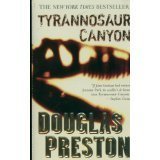
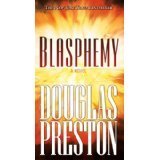 Tyrannosaur Canyon Blasphemy
Tyrannosaur Canyon BlasphemyQuestion fifteen: Do you already have a project idea for once Dual Sight is finished?
In addition to editing Dual Sight, I’m working on a novel I started years ago but left orphaned until recently. The working title of that book is Trio. I’m looking forward to spending time with the characters. They have been with me for a long time, but I’ve not felt comfortable writing the story until this year.
Why is that?
Since this story has so many subplots associated with the main plot, I’d really like to do the story justice. Until now, I haven’t felt my abilities worthy of that goal.
Question sixteen: What one thing about self-publishing do you find most disappointing?
Well, to be honest, I’m happy with the physical product quality CreateSpace provides as well as the Kindle experience for ebooks. So I’m not disappointed in the self-publishing experience per se. However, there is one thing I find deflating.
And that is?
I don’t know if I’m speaking for all authors here. I suppose when an author is selling millions and millions of books, be it print or ebook, it doesn’t really matter what people think of your work. Still when you boil it down to the smallest particle, I think a writer wants to know what people think of what he/she has written.
Why does it matter? I mean you’re presenting a story right?
That’s true, but still it’s nice to get feedback on any aspect of the story regardless if it’s a scene, a character, a conflict, etc. It feels good to find out the effort wasn’t wasted. I guess the bottom line for me is, did the reader enjoy the story and did it entertain them? Also, if there’s a flaw in the story it’s good to know that too. The best way to convey this to the author is by reviewing the book. So the one thing that disappoints me is the number of reviews I’ve gotten versus the number of books that have been downloaded as ebooks.
Question seventeen: Why are reviews so important to self-published authors?
Reviews are important to any author. The fact is, no matter how much effort a publisher or author does to promote a book, reviews by readers do more to move a book off the shelves than anything. Actually a review is a personal announcement to read or not to read a book. When someone tells a friend they should read a book it becomes an endorsement of the work. People generally respond to personal endorsements and buy books. Also you can use a review to give the author a pat on the back expressing to them how much you enjoyed the book.
Is that important to you?
Absolutely. The last thing I want is for a reader to finish a book and feel the time they’ve spent with the characters in the story wasn’t worth their investment. I’ve been there. I consider myself a slow reader, so for me to put days into reading a book isn’t uncommon. When I finish reading a book, I want to be richer for the experience. What I don’t want is to regret giving the author my time by experiencing disappointment. As an author, I don’t want a reader to have that feeling after they finish one of my books. If they do, then I’ve failed them. But if I did and they don’t tell me how will I ever know?
Question eighteen: What is your favorite review thus far?
My favorite review is one that isn’t published on Amazon, Goodreads, or anywhere. A lady told me she loved reading The Hurting Place. I told her I was glad she enjoyed it. Then she told me she doesn’t usually read books, but found the experience a good one. Hearing that made me feel great, because I love to read, and giving someone a pleasurable experience is worth the hours it takes to write a story.
Question nineteen: Do you ever suffer from the dreaded writer’s block?
I guess I’d have to answer that with a yes and no response. I think most authors that have spent any amount of time writing have come to a point in a story where the story doesn’t move forward. At that point, the effort of writing feels like slogging through the swamp compared to a point when writing the story was like driving in the Indy 500. That is when writing is fun. The story is moving, and the characters are interacting.
What do you do when the story slows down?
If I’ve got something else going on, it helps me to step away for a while and work on something else. Writing a short story or a chapter for another work frees up the creative juices and helps me get things rolling again. That is the yes I do answer. Now, for the no answer. Once I get started on a story, it’s amazing to me how the characters stay with me. It’s like they are pushing me to finish their story. What I mean by that is, even when I’m not writing they’re still talking and interacting in my head. I could be driving down the road, mowing the grass, working in the yard, etc. So ideas are coming and going in my head all the time. Some make it to the page, while others don’t. It’s like listening to a group of people at a party talking about a hundred different things. Some are interesting while others don’t do anything for me. But when something really strikes me as good, I return to writing the story. Without fail, we begin moving forward.
Question twenty: What is your least favorite part of the writing process?
 Each tab is an active edit.
Each tab is an active edit.That’s easy. I dislike the process of editing. Writing the first (rough) draft is fun for me. I enjoy watching the story unfold and move toward the conclusion. Once it’s finished, a writer has to step away from the creation and see the flaws in the writing. The harsh truth is that the story isn’t as good as it could be and should be after the initial writing. So the process of making the story better begins. The hard part is trying to find the sweet spot in the editing process. While the story may read fine, there are always going to be tweaks, cuts, additions, changes, etc. that will enhance the flow of the story.
So do you think it’s possible to edit a story death?
Yes, I think that’s the case. It’s sort of like plastic surgery. You start with a little nip here and a tuck there. You step back and are amazed at how better it looks and reads. So if a little is good more should be better. You cut first one scene then another. You rearrange this chapter and that chapter. A little more here and a little less there then finally you don’t know where your original story stopped, and the edited story started. In over editing you might just edit out the thing about your story that made it uniquely yours. Film directors sometimes say the best parts of the movie are on the editing room floor. Years later the studio releases a director’s cut version of the film with the statement: “This is the director’s vision for the film.” So I think sometimes you just have to stop and let it go. It will never be perfect in everyone’s eyes. So it’s important for a writer to accept the work for what it is and move on to the next tale.
Question twenty – one: What is the story Trio about?
Like I said, Trio is a story that’s been with me for a very long time. It’s a story about a tragic day that altered the lives of three families. I’ve set the event of the story in West Virginia in the early seventies with the beginning of the story set in the present. Three grade school friends reunite to deal with the pain of the day each has been unable to overcome in forty plus years.
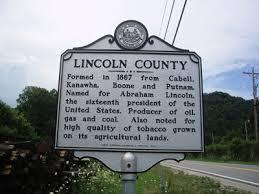
Are there any facts associated with this tale?
No. This is pure fiction crafted from the mind of Rob Cummings. It’s a story I hope the reader finds entertaining and worthy of reading.
And reviewing?
Of course.
Thank you Rob for your time and I look forward to our next visit.
As do I. Until our next visit. Keep reading. : )
Published on August 02, 2014 12:25
April 28, 2014
Twenty one questions with author Rob Cummings about his book Moonlight Sacrifice.
Hello readers. My name is Frank Dunn and Rob has asked me to conduct this interview. Rob is with me now so let’s get started.
Hello Rob.
Hello Frank.
Question one: Who would you consider to be the ideal reader of Moonlight Sacrifice?
Although you could put the book in the mystery genre, I’d have to classify it as a “how done it” rather than “who done it." So anyone wanting to solve a murder mystery will not like this book. However, if you like to read a book with lots of character interactions and development, you’ll like this.
Question two: What sparked the idea for the book?
That’s a little difficult to pin down to one thing. There usually isn’t one thing that gives me an idea for a story. More often than not, it’s a cumulative thing. Several ideas come together to create an idea that sort of forms like a little storm in my mind, and before I know it there is a story brewing. As for Moonlight, it started out years ago as a short story of some four thousand words. The idea was to create a character that wanted to leave a mark on the world, but due to circumstances was unable to make the mark he wanted. So that was one point. Another point was the question of suicide and the idea of if it would ever be okay to sacrifice oneself for the greater good. Add to that the idea of considering his death an act of euthanasia. One final ingredient for this story was having the character’s death prevent the committing of a crime. The goal was to make all of these seem plausible.
Now having said that I need to say the idea of making my short story titled Luna into a full-blown novel didn’t come about until October of 2011. I needed something to write about for the National Novel Writing Month challenge (NANOWRIMO) which takes place each November. I decided I could take the short story and make a novel out of it. It took me two years to complete the work so it is actually twice as large as it needed to be, but when the 2011 challenge ended I felt I was only half way through the story and so I completed it the following year in 2012.
Question three: What does your writing process look like?
Well, I usually begin with a title, and I try to write to make the work resemble as closely as possible what it says. At one point in time, I toyed with the idea of calling the book Moonshine, and although that would have worked just fine, it wasn’t quite right. When I hit upon Moonlight Sacrifice, I immediately had the feeling it was the way I wanted to go.
Now for the actual physical process, I write best in what I call immersion. What I mean by that is I’ll select some music from the music player on my laptop and put in the earbuds and start writing. Most people would think it would be a distraction, but the distractions come from outside the world I’m creating. All the music does is set a tone or pace for the story and provide soothing noise to write by.
Question four: Would you consider yourself a plotter or a pantster?
Although I’d have to say I’m really a pantster I can’t get away from having some idea of where the story is going. So I don’t script or plot the story as A to B to C to D but I do know where it begins at A and when I’m done the story will be at D but the middle is wide open for my muse to form as he sees fit. I find if I don’t restrict him to stay on a planned path he’ll come up with much better ideas than I could have on my own. Not all of his ideas are good, but I find most of them are. Also, not knowing which path the story is going to take leads to some amazing surprises for me and in that way, it’s almost as if the story is unfolding before my eyes and I get to experience its birth on the page. For me, that’s the best part of writing.
Question five: What is your favorite scene or chapter in the book?
My favorite chapter is seventy six. It's the next-to-last chapter and the one that was the hardest to write. The reason for that was through the previous seventy five chapters I got to know Rocky Moon almost as a person. When you kill a character that you've come to know and love it can be very personal. It can touch you heart in ways you never thought would be possible. I guess you could say my favorite chapter is when we say goodbye to Rocky.
Question six: Would you share some of that?
Sure.
Rocky’s arm grows heavy and crashes down to his side. He wants to watch Randy go, but is suddenly unable to remain upright. He falls back into the chair. Overhead the moon’s softness becomes austere and harsh. Rocky looks one last time at his namesake, and as he watches, the edges of his sight begin to close in on the circumstance of the orb. It squeezes the emptiness around the heavenly light until it touches all around. In that instant, Rocky Moon can only see his beloved moon and in the next, he sees nothing.
Question seven: Is it difficult to kill a character you have come to love?
For me it is. I had quite a bit of blood flying in this book and only had difficulty with Rocky’s death. It took a while to write that chapter, and I tried to write it in a way that would put some distance between us. It was less hurtful that way.
Question eight: What authors inspire you?
I have an extreme admiration for Stephen King. The first book of his I ever read was The Dead Zone. I can still remember the feeling of having the story draw me in so much that I almost became part of that world. I saw the story instead of read it. It was a surreal experience.
I also enjoy the works of Nicholas Evans, Clive Cussler, and Richard Russo.
Question nine: Which character in the book do you relate to most?
That’s an easy question. The answer is Officer Frank Dunn.
Why do you relate to me?
I needed you to be someone who would do the right thing. Rocky needed to rely on your desire to be true to yourself and above all honest. So I tried to make you, me.
Question ten: What was your favorite quote from this character?
In the prison when you spoke to Dennis you said: “Dennis, I hope you realize you’re on the wrong bus.”
Okay, Rob thanks for your time. We’ll have to finish the other half of these questions later if that’s okay with you.
You bet.
Thanks again.
No, thank you Frank.
Until next time, keep reading. : )
Published on April 28, 2014 15:05
February 6, 2014
Old Habits Die Hard
With the arrival of the year 2014, I’m sure we all plan to make some changes. I can still hear myself saying, “This year there are going to be some changes around here.”
So what is the top resolution for 2014? Well, according to Statisticbrain.com number one is the age-old favorite to lose some weight. That’s understandable. After eating all the left-over Halloween candy, enjoying all those Thanksgiving meals, and the snacks, treats, and dishes associated with Christmas, I bet most people have put on a few extra pounds. Of course, I’m like most people, so that was one of my resolutions. Along with promising my doctor, I’d get some exercise and get healthy or at the very least healthier. That shouldn’t be too hard. Should it? I’ll just change some of my behaviors. That should be easy.
I’m sure we’ve all tried to change some behavior in our life we wanted to be shed of. Sometimes it’s something so ingrained in our hearts and minds that we simply can’t manage to extricate it from our lives. Our best efforts fail, in some instances … repeatedly. Ah but isn’t that why humans are called creatures of habit. We like comfort, and our habits are the pacifier that sooths our spirits. We enjoy our habits because they make us who we are.
Statisticbrain.com tells us that only 38% of those individuals that resolve to lose weight will achieve their goal. They also state that by the first of February, 36% will have fallen by the wayside. Why is that when only thirty two days ago we were all so dead set on making a change?
When we decide to overcome, one or more, of our proclivities, we wage war against what is normal for us as individuals. What we want to do is exact some change on ourselves to become – hopefully – a better person. We would like the transition to be an easy one, but sadly change is never easy. Change is really about waging war against one’s self. It’s about launching an attack against the subconscious mind and forcing the brute to cease and desist those less than acceptable acts we so cherish. If we are steadfast and victorious, we will win the day and cast off the garment our habit has clothed us in. But be wary. These attacks can have devastating after effects should we fail at our endeavors.
Some late night when we should be in bed, our stomachs will growl, and we’ll decide to go exploring. “What’s in this cabinet? What’s left over in the fridge? Do I smell cake? Is there ice cream? How did these potato chips get here?” Then we find ourselves sprawled out on the couch with icing on our face and empty potato chip bags at our feet. We feel bad. We feel defeated. We give up because it’s just too difficult to exact a change. What we should do is shake it off. Get back up on that treadmill and tread upon that meal. It’s not over until you decide it’s over so don’t quit. Change is never easy, but if you make a habit out of taking steps to eliminate a habit soon enough you’ll be enjoying a new habit associated with a new you. Hang in there you can do it.
Until next time, keep reading. : )
So what is the top resolution for 2014? Well, according to Statisticbrain.com number one is the age-old favorite to lose some weight. That’s understandable. After eating all the left-over Halloween candy, enjoying all those Thanksgiving meals, and the snacks, treats, and dishes associated with Christmas, I bet most people have put on a few extra pounds. Of course, I’m like most people, so that was one of my resolutions. Along with promising my doctor, I’d get some exercise and get healthy or at the very least healthier. That shouldn’t be too hard. Should it? I’ll just change some of my behaviors. That should be easy.
I’m sure we’ve all tried to change some behavior in our life we wanted to be shed of. Sometimes it’s something so ingrained in our hearts and minds that we simply can’t manage to extricate it from our lives. Our best efforts fail, in some instances … repeatedly. Ah but isn’t that why humans are called creatures of habit. We like comfort, and our habits are the pacifier that sooths our spirits. We enjoy our habits because they make us who we are.
Statisticbrain.com tells us that only 38% of those individuals that resolve to lose weight will achieve their goal. They also state that by the first of February, 36% will have fallen by the wayside. Why is that when only thirty two days ago we were all so dead set on making a change?
When we decide to overcome, one or more, of our proclivities, we wage war against what is normal for us as individuals. What we want to do is exact some change on ourselves to become – hopefully – a better person. We would like the transition to be an easy one, but sadly change is never easy. Change is really about waging war against one’s self. It’s about launching an attack against the subconscious mind and forcing the brute to cease and desist those less than acceptable acts we so cherish. If we are steadfast and victorious, we will win the day and cast off the garment our habit has clothed us in. But be wary. These attacks can have devastating after effects should we fail at our endeavors.
Some late night when we should be in bed, our stomachs will growl, and we’ll decide to go exploring. “What’s in this cabinet? What’s left over in the fridge? Do I smell cake? Is there ice cream? How did these potato chips get here?” Then we find ourselves sprawled out on the couch with icing on our face and empty potato chip bags at our feet. We feel bad. We feel defeated. We give up because it’s just too difficult to exact a change. What we should do is shake it off. Get back up on that treadmill and tread upon that meal. It’s not over until you decide it’s over so don’t quit. Change is never easy, but if you make a habit out of taking steps to eliminate a habit soon enough you’ll be enjoying a new habit associated with a new you. Hang in there you can do it.
Until next time, keep reading. : )
Published on February 06, 2014 07:06
October 21, 2013
Belize It
 These flowers were in boom right outside our beach door.
These flowers were in boom right outside our beach door.  This spider monkey was the beginning of our trip up the New River to the Mayan ruins at Lamanai. Lamanai means 'submerged crocodile' but we didn't see any.
This spider monkey was the beginning of our trip up the New River to the Mayan ruins at Lamanai. Lamanai means 'submerged crocodile' but we didn't see any.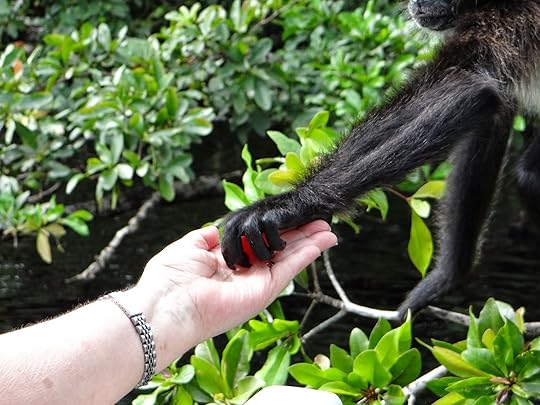 He liked watermelon and we treated him with several pieces. Our guide I. C. told us his mate died several years ago and now he is all alone.
He liked watermelon and we treated him with several pieces. Our guide I. C. told us his mate died several years ago and now he is all alone. Water hyacinth along the river.
Water hyacinth along the river. A Jacana or Jesus Bird if you prefer. Walks along the debris along the banks of the river.
A Jacana or Jesus Bird if you prefer. Walks along the debris along the banks of the river. Insect bats sleeping the morning away waiting for the dinner bell to ring in the evening.
Insect bats sleeping the morning away waiting for the dinner bell to ring in the evening. A hermit crab? I didn't have a guide for this but I suppose he arrived at our condo while we were away. Catch you later.
A hermit crab? I didn't have a guide for this but I suppose he arrived at our condo while we were away. Catch you later. Flora beside the pool.
Flora beside the pool. A flyover while we traveled to the Hol Chan Marine Reserve located at the southern end of Ambergris Caye Island.
A flyover while we traveled to the Hol Chan Marine Reserve located at the southern end of Ambergris Caye Island. This coral formation is near one of the deep parts of the reserve that allows boats to pass out into the Caribbean. The sentry let us pass.
This coral formation is near one of the deep parts of the reserve that allows boats to pass out into the Caribbean. The sentry let us pass. Coming back in through the pass. San Pedro is in the background.
Coming back in through the pass. San Pedro is in the background.I think it rained every day we were there, but mother nature blessed us by washing everything at night while we slept. One particular night I heard it raining rather hard. It woke me up and I couldn't go back to sleep. After about an hour, I decided to go and read. When I walked into the living room, I saw that the sun was coming up so I walked out onto the pier with my camera and took these pictures.


 I believe this is a black cowbird, but I could be mistaken. Moments after I took this picture, he turned over a piece of coconut tree bark to see if any bugs were underneath. Or maybe he wanted something else. He left disappointed.
I believe this is a black cowbird, but I could be mistaken. Moments after I took this picture, he turned over a piece of coconut tree bark to see if any bugs were underneath. Or maybe he wanted something else. He left disappointed. Condo inhabitant. I was just visiting. He actually lives there beneath the bush.
Condo inhabitant. I was just visiting. He actually lives there beneath the bush. His Cousin? He lives there too. I envy them both.
His Cousin? He lives there too. I envy them both. A ray that passed beneath the pier walkway. I wanted to see a spotted eagle ray, but this guy will have to be good enough.
A ray that passed beneath the pier walkway. I wanted to see a spotted eagle ray, but this guy will have to be good enough. The view down from the top of the High Temple at Lamanai. The temple is 108 feet from the plaza. I took this picture with my cell phone.
The view down from the top of the High Temple at Lamanai. The temple is 108 feet from the plaza. I took this picture with my cell phone. The view of the lagoon. Fresh spring feed water fills it and creates the New River that flows north to the sea. The Mayan's built there city near the lagoon and had to raise it some ten feet when it was flooded.
The view of the lagoon. Fresh spring feed water fills it and creates the New River that flows north to the sea. The Mayan's built there city near the lagoon and had to raise it some ten feet when it was flooded.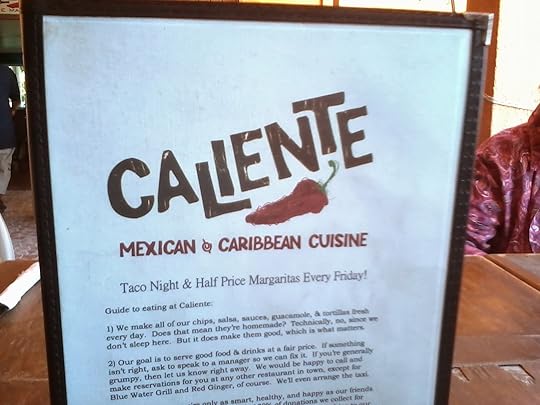 The view of the menu of our favorite restaurant. Every Friday night is taco night and half price margaritas. Wish I'd know that before I left on Friday.
The view of the menu of our favorite restaurant. Every Friday night is taco night and half price margaritas. Wish I'd know that before I left on Friday.
The view from Caliente of some fisherman cleaning the days catch.
The water was a clear green. The sky a brilliant blue. The people were happy and friendly. We had a great time at Wayo's bar on the beach. Walking through the Atlanta airport, we started making plans for our next visit. You better Belize it we'll go back.
Until next time keep reading and I'll catch you later. : )
Published on October 21, 2013 17:40
October 2, 2013
Up Up and Away
Every year in September my wife and I journey to northern New York State with her parents. We usually enjoy this trip over Labor Day weekend. However, this year due to her schedule we delayed our trip until the end of September. Over the years, we've had to make our trip even later having to venture up a couple of times in October harrowingly close to cold weather. This year the end of September worked just fine.
One of the things I've gotten to see often is hot – air balloons drifting up from Letchworth State Park. The park, affectionately dubbed "The Grand Canyon of the East" is a splendid jewel. Anyone having seen the spectacular vistas would no doubt give an affirmative nod to the title. Every year we manage to find time to enjoy a leisurely drive through the park to view the abundance of deer and take in the scenery.
This year we were treated to an added bonus. As we arrived at the middle falls parking area, two hot – air balloons were preparing to launch. We immediately parked and got out to witness this event. Unfortunately, as fate would have it, our camera was safely resting at the house some ten miles away. Since our planned journey had consisted of a trip to Batavia for lunch at our favorite Chinese food establishment, it didn’t seem necessary to lug the camera along. A note to myself and anyone interested in taking photos. Treat your camera like an American Express card. Don’t leave home without it. I know I won’t as the pictures I managed to take were captured with my cell phone.

Our view upon arrival.

Getting up

Almost ready
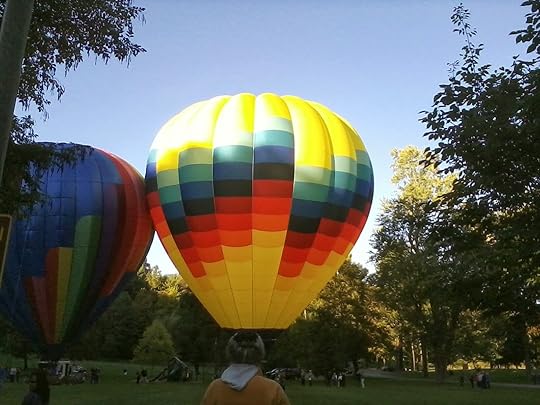
Once both balloons were inflated they managed to enjoy the company of the other as the crew completed heating the air and preparing for their departure.
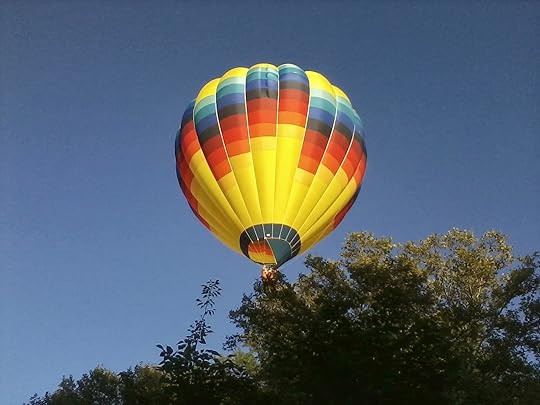
Once the balloon was ready, it didn't take it long to leap into the sky and soar over the trees along the edge of the cliff, but after it moved over the water it became apparent it was going to try and touchdown into the Genesee River which flows through the canyon.

The balloon just barely touched the water before it regained some distance and stabilized itself a few feet above the water.
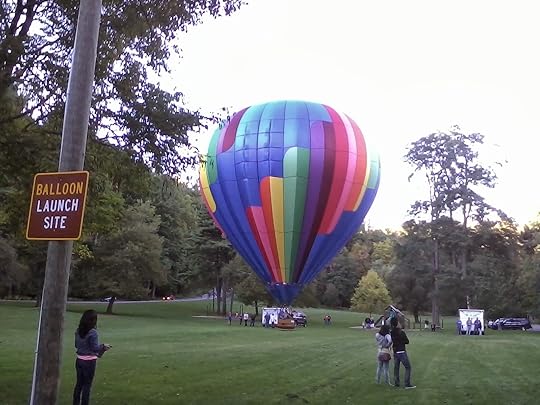
Meanwhile back at the launch site. The second balloon prepared to join his buddy.
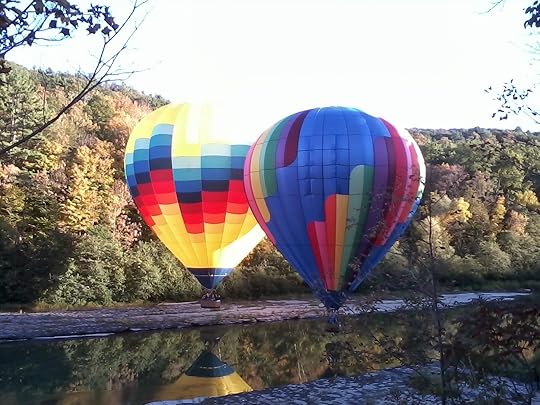
This is when my wife's uncle told me they were going to go over the falls and we headed for the overlook as quickly as we could.

This is the middle falls of Letchworth State Park

Here come the balloons

Heading over the falls
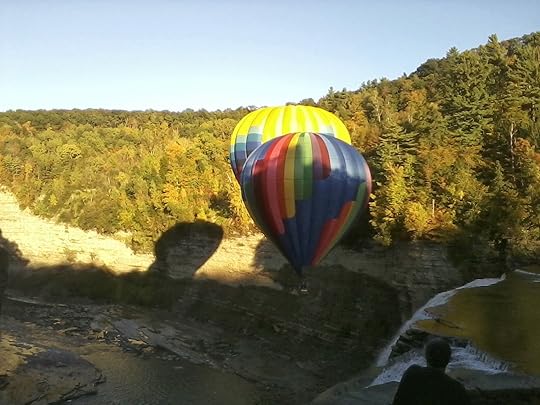
It was a smooth transition from being a few feet off the water to being hundreds of feet off the water

After a few minutes inside the canyon, the balloons separated and headed for wind that took them back up the river.

http://nysparks.com/parks/79/
Giving credit where credit is due.This picture is from the Letchworth State Park site
Watching these two balloons take flight was a wonderful thing. I got so caught up in the excitement of the experience I have no idea where three of our party viewed this event. My father - in - law had a better vantage point to take pictures and when I get those I'll add them to this post. He was closer to this view. My photos were taken from the viewing area overlooking the falls. The few minutes it took for all this to happen made the entire trip. Next time maybe I'll be in the balloon taking pictures of the ground. That would be awesome too.
As I promised the following three pictures were taken by my Father-In-Law from above the falls viewing area.



Good job Max. I hope you enjoy these shots.
Until next time keep reading. : )
One of the things I've gotten to see often is hot – air balloons drifting up from Letchworth State Park. The park, affectionately dubbed "The Grand Canyon of the East" is a splendid jewel. Anyone having seen the spectacular vistas would no doubt give an affirmative nod to the title. Every year we manage to find time to enjoy a leisurely drive through the park to view the abundance of deer and take in the scenery.
This year we were treated to an added bonus. As we arrived at the middle falls parking area, two hot – air balloons were preparing to launch. We immediately parked and got out to witness this event. Unfortunately, as fate would have it, our camera was safely resting at the house some ten miles away. Since our planned journey had consisted of a trip to Batavia for lunch at our favorite Chinese food establishment, it didn’t seem necessary to lug the camera along. A note to myself and anyone interested in taking photos. Treat your camera like an American Express card. Don’t leave home without it. I know I won’t as the pictures I managed to take were captured with my cell phone.

Our view upon arrival.

Getting up

Almost ready

Once both balloons were inflated they managed to enjoy the company of the other as the crew completed heating the air and preparing for their departure.

Once the balloon was ready, it didn't take it long to leap into the sky and soar over the trees along the edge of the cliff, but after it moved over the water it became apparent it was going to try and touchdown into the Genesee River which flows through the canyon.

The balloon just barely touched the water before it regained some distance and stabilized itself a few feet above the water.

Meanwhile back at the launch site. The second balloon prepared to join his buddy.

This is when my wife's uncle told me they were going to go over the falls and we headed for the overlook as quickly as we could.

This is the middle falls of Letchworth State Park

Here come the balloons

Heading over the falls

It was a smooth transition from being a few feet off the water to being hundreds of feet off the water

After a few minutes inside the canyon, the balloons separated and headed for wind that took them back up the river.

http://nysparks.com/parks/79/
Giving credit where credit is due.This picture is from the Letchworth State Park site
Watching these two balloons take flight was a wonderful thing. I got so caught up in the excitement of the experience I have no idea where three of our party viewed this event. My father - in - law had a better vantage point to take pictures and when I get those I'll add them to this post. He was closer to this view. My photos were taken from the viewing area overlooking the falls. The few minutes it took for all this to happen made the entire trip. Next time maybe I'll be in the balloon taking pictures of the ground. That would be awesome too.
As I promised the following three pictures were taken by my Father-In-Law from above the falls viewing area.



Good job Max. I hope you enjoy these shots.
Until next time keep reading. : )
Published on October 02, 2013 21:32
September 21, 2013
The Hurting Place
‘The Hurting Place’ didn’t start out as many stories do. It didn’t enjoy a smooth and effortless transition from idea to finished work. In fact, the idea for which I intended to use the title is an unfinished orphan so well hidden that I cannot locate its whereabouts. Maybe it’s served its purpose and if that was only to act as a place holder for the title, then I guess I should be thankful. In my opinion, the title fits the story. With it attached to the manuscript, I managed to craft a story I doubt I'd have accomplished with the previous title. So here is how it all worked out.
The first germ of an idea occurred in the fall of 1980 when I arrived at Concord for my freshman year. My housing assignment placed me in The Towers, which stood in the shadow of the remains of an old water tower. Every day, I passed by this tower on my way to and from classes. I heard many stories associated with the tower, but the one that was the most interesting was that the students used to cut the lock off the service door and go swimming in the tower. This story was freely passed down from class to class for years. I can only imagine there are thousands of former students who are receptacles.
Years later the story of an accidental death surfaced in the nearest town. Apparently, someone decided the story of someone swimming in the water tower sounded good. This person decided to go about doing just that in an active water tower. Once inside the tank they quickly realized exit from the water was impossible. How long it took for this person to perish is only speculation, but I’d think it wasn’t a short amount of time.
The question I posed myself was: If I was the person in the tank, and I knew what the outcome would be how would I spend my last few living hours? This is the idea I started with in 2002. The title of the story was to be: ‘In Trouble Deep’. I set to work and started writing the story. The total word count of my effort was less than five hundred. The problem was I wasn’t comfortable with the approach I’d taken to tell the story. I wanted it to be introspective on the part of the swimmer concerning his life. Where had he been successful and where had he failed. As much as I tried to make something happen, I couldn’t get the story to move.
Even though I couldn’t get anything out of ‘In Trouble Deep',’ I liked the pieces that had given me the idea for the story. On the other hand, ‘The Hurting Place’ had been assigned to a story about a homeless man who had met a gentleman who had befriended him and offered to provide him a place to reside should he ever decide he wanted to live in a home and not on the street. It is another story that failed to move, but I really liked the title. So I took the title ‘The Hurting Place’ from one story and gave it to the water tower story that had stalled. I flipped the idea around and set to writing.
The odd thing about the process was that it wasn’t linear. That is to say, I didn’t start on page one and write until I reached ‘the end’. I wrote scene chapters as they came to me over a course of nine years. When I would share these pieces with fellow writers, and they asked where I was in the story I couldn’t tell them. All I knew was that I wasn’t finished, but the story was moving along. Slowly, but I was making progress. By the way, I wouldn’t recommend this method if you want to write a novel. It was very time-consuming and difficult. But I think I ended up with a nice story.
Okay, that’s how The Hurting Place got its name.
Until next time keep reading.
The first germ of an idea occurred in the fall of 1980 when I arrived at Concord for my freshman year. My housing assignment placed me in The Towers, which stood in the shadow of the remains of an old water tower. Every day, I passed by this tower on my way to and from classes. I heard many stories associated with the tower, but the one that was the most interesting was that the students used to cut the lock off the service door and go swimming in the tower. This story was freely passed down from class to class for years. I can only imagine there are thousands of former students who are receptacles.
Years later the story of an accidental death surfaced in the nearest town. Apparently, someone decided the story of someone swimming in the water tower sounded good. This person decided to go about doing just that in an active water tower. Once inside the tank they quickly realized exit from the water was impossible. How long it took for this person to perish is only speculation, but I’d think it wasn’t a short amount of time.
The question I posed myself was: If I was the person in the tank, and I knew what the outcome would be how would I spend my last few living hours? This is the idea I started with in 2002. The title of the story was to be: ‘In Trouble Deep’. I set to work and started writing the story. The total word count of my effort was less than five hundred. The problem was I wasn’t comfortable with the approach I’d taken to tell the story. I wanted it to be introspective on the part of the swimmer concerning his life. Where had he been successful and where had he failed. As much as I tried to make something happen, I couldn’t get the story to move.
Even though I couldn’t get anything out of ‘In Trouble Deep',’ I liked the pieces that had given me the idea for the story. On the other hand, ‘The Hurting Place’ had been assigned to a story about a homeless man who had met a gentleman who had befriended him and offered to provide him a place to reside should he ever decide he wanted to live in a home and not on the street. It is another story that failed to move, but I really liked the title. So I took the title ‘The Hurting Place’ from one story and gave it to the water tower story that had stalled. I flipped the idea around and set to writing.
The odd thing about the process was that it wasn’t linear. That is to say, I didn’t start on page one and write until I reached ‘the end’. I wrote scene chapters as they came to me over a course of nine years. When I would share these pieces with fellow writers, and they asked where I was in the story I couldn’t tell them. All I knew was that I wasn’t finished, but the story was moving along. Slowly, but I was making progress. By the way, I wouldn’t recommend this method if you want to write a novel. It was very time-consuming and difficult. But I think I ended up with a nice story.
Okay, that’s how The Hurting Place got its name.
Until next time keep reading.
Published on September 21, 2013 15:35
April 30, 2013
The Making of a Storyteller ( Part 3 )
Okay so where was I when last we visited? Now I remember. I was telling you about my recounting TV shows to my fellow students. Let’s carry on.
In grade school, I managed to compose some poetry. I know now that I was only sticking my toe in the water to see how it felt. It must have felt okay because I kept at it, and once I got in high school; I started receiving some positive feedback from people whose opinions I valued. That feedback encouraged me to keep putting words on paper. My sophomore year English teacher labeled me a romantic. This shocked me. How could that statement be true? I wanted the stories I’d started to write to reflect Poe and Sterling. I resisted accepting that brand applied to my writing.
Now – after more than thirty years – I know she had me pegged correctly. It’s funny how sometimes people looking from the outside in can see more than the person on the inside looking out. Even though I now accept that label, it took years to get comfortable with it. Such is life.
In college, I continued to straddle the fence of storytelling. I wrote poems and some short stories. Some were okay but most fizzled out and didn’t amount to much. Once I graduated from college, I decided I wanted to see if I could sell some of the words I’d written onto the page. I became a Writer’s Digest subscriber and a book club buyer. With no typewriter available, my stores were poured out into notebooks and loose leaf sheets of paper. I entered contests not hoping or expecting grand prizes or awards. Sometimes a simple nod can go a long way, and I think most writers just want someone to say, “I liked that story.”
Starving for acceptance or appreciation is a difficult path to walk. Every moment without feeling that joy is like existing as a water starved houseplant. Every day, the dirt gets a little harder and the leaves become more brittle. Then one day a stiff wind comes along and kills the last bit of life left in your dream. The books go onto the shelf. The subscription is canceled. The notebooks with dozens of stories and pages and pages of poetry go into a box that finds its way into a dank dark moist basement. Years later that box degrades and falls apart. The papers damp and rotted beyond rescue find their final resting place in a bag of trash.
Years later, I typed some words into an email and hit send. I didn’t expect anything. I just wanted to let the lady on the receiving end of that note to know how I felt about her. With her words of encouragement, I continued to peck out more and more lines. She insisted I write more, and I did. Before long, I had the first attempt at a short story in years. When she read it, she liked it, but wanted it bigger, fuller, and bolder. I stretched the story and bulked it up, but it never became more than a short story. Wake Me Up Someday is hanging around on a hard drive waiting for a little work and a rough polish. Someday it’ll get both. I'm sure.
Keeping company with that story is others. These orphans may one day get their chance and come back to the forefront again. If not I’ve learned some things from them, so they haven’t been works without merit. Each one has given me more and more confidence in what I love doing. Also they’ve helped me embrace the romantic inside me, and that’s okay. What would this world be without love? Thanks Theresa for all your love and encouragement.
When next we meet I’ll give you the back story of The Hurting Place. Until then keep reading. : )

Published on April 30, 2013 19:23
April 18, 2013
The Making of a Storyteller ( Part 2 )
Looking back now, I think it would be safe to say that Robinson Cursoe was an ambitious book for a ten/eleven year old to attempt. However, when the book was finally finished there was a feeling of great accomplishment. Completing that book gave me the confidence to read other books. Most of the books will never be measured against Defoe’s tale, but each had its own value. If for no other reason, they provided entertainment.
The library of Griffithsville Elementary School was no public library, but it did offer a wealth of reading opportunities for its students. Many of which I read or at the very least perused well enough to decide not to read. Among the books that entertained me were Between Planets, Red Planet, and Space Cadet. These books were written by Robert Heinlein a noted master in the realm of science fiction.
Another writer I enjoyed reading was Curtis Kent Bishop. He wrote sport stories dealing with football, baseball, and basketball. Two of those three interested me and I learned if the book had his name on it, it was worthy of reading. One of his books – Lank of the Little League – is still with me as a fond memory. That either speaks positively for my memory, the quality of his writing, or both.
The first book I ever read more than once was Sabre Jet Ace written by Charles Ira Combs. This book is the story of Joseph C. McConnell a fighter pilot in the Korean War. He was the first triple ace jet fighter pilot. I think I enjoyed this book the second time I read it as much as I did the first. Once again, I can thank my mother for this joy. Having told her I couldn’t find anything at the library I hadn’t already read, she suggested I reread a book that I previously enjoyed. Hesitant at first, I soon realized really good stories can be read and reread over and over. Thanks again mom.
But reading isn’t the only thing that played into my love of telling stories. During my time in grade school and later high school, I was blessed with the task of being one of the first students to arrive at the school every day. In those days in the sixties, when students arrived at school, they entered their classrooms and found something to occupy ourselves with until the beginning of school. On many occasions, we would gather to talk about what was on TV the previous night.
“Did you see Gunsmoke last night?” I might ask one of my classmates.
“No, what was it about?”
That was all it took to launch me into a detailed oral reconstruction of the entire show. I felt I needed to speak to every lift of a hat, every order of whiskey, or every draw of a gun. To tell of the goings-on’s of an hour TV show took time. But somehow I finished before class started. On the rare occasions when I didn’t there was recess to complete the telling.
Almost always before I finished I had a gathering of nearly a dozen fellow students standing around my desk hanging on my every word and detail. I must have done a good job conveying the story, because I was soon being requested to recount other shows I’d seen the night before. More than once I had friends tell me they didn’t need to watch a show they just needed to make sure I did. That way, I could recount everything to them the next day. That was okay by me.

When next we meet part 3. Until then happy reading. : )
Published on April 18, 2013 06:56
April 11, 2013
The making of a storyteller ( Part 1 )
The biggest influence on my love of reading and stories was my mother. Some of my fondest memories from childhood were on the nights she would read or tell me and my brother a story. My mom grew up the oldest of eight children in a coal mining community. Being the oldest child put her in the unique position of helping to raise her siblings. I’m sure many of the stories she told them at night were also the stories she told us at night.
Of course there were the standards. Goldilocks and the Three Bears, Little Red Riding Hood, Jack and the Beanstalk, and my favorite, and I think her’s as well, Epaminondas and his Auntie. Most stories she told us were recited and not read, but later on we did get a great number of stories read to us from one of my older brother’s school books. As desperately as I’ve tried, I cannot recall the name of the book or any of the names of the stories in the book. One thing I do remember is that when she opened this book to read, I opened my ears to listen.
It is from that book that I developed a love of stories put down on paper. It was almost like some magical spell fell upon me when she read the words from the page that transported me from the comfy covers of our bed to the grassy plains of the Midwest. In that land of buffalo and Indian braves I got to experience an excitement far beyond the reaches of our valley. So it was that I longed for that red book to be opened so I could be once again the hero of the story.
From this love of words it would be reasonable to conclude that I had no problem learning to read. Far be it from the truth. Learning the mechanics of reading somehow eluded me. Not until the fourth and fifth grade did I become comfortable holding a book in my hands and reading the words on the page. That is when I bloomed as a reader and began to use our grade school library to its full advantage.
The first book I can recall reading on my own was Robinson Crusoe. I proudly sat down every evening after dinner and turned the pages eager to see what was to happen to Robinson. Not many days after I started this Everest of words my mother asked if she could read it too. I was happy to allow her to read this book. It would only add to her vast collection of stories. The next day the book remained home as I went to school. That evening after dinner I asked her if she wanted to read the book that night. To my horror she told me she had already finished it. She read in a day what it took me two weeks to accomplish. At first, I felt dejected because it was taking me days to read the book she’d managed to finish in hours. I put down the book determined to let it go unfinished.
When my mother realized I’d stopped reading the book, she questioned me as to what had caused me to abandon the story. I explained to her that it must be too challenging of a book for me since she had read it in a few hours and after days I’d only managed to scratch the surface. She told me that everyone reads at different paces based on their reading expertise and the personal desire to finish the story. This made sense to me, and I rejoined Robinson on the island now content to stroll along the words rather than rush through them making sure to take my time and savor all their meanings.
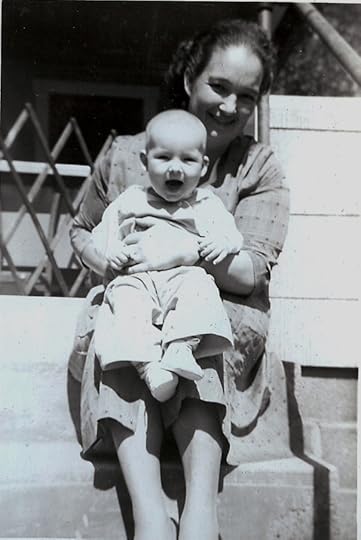
When next we meet part two. Happy reading.
Published on April 11, 2013 11:04
March 27, 2013
A couple literary did you knows?
I love books. I can thank my mother for this. She introduced me to stories and the books wherein many of them reside. I say this because one of my favorite stories she told my brother and me during our childhood is nowhere to be found in print, so it must have made its home with her. One of the best stories I know, but not what I want to write about. So I’ll begin with the first literary oddity.
Do you know what a lipogram is? If you don’t already know, then you will be surprised to learn that a lipogram is a written work composed in such a manner as to avoid the use of one or more alphabetic characters. Thank you dictionary.com.
Ernest Vincent Wright would you please take the stage please. Mr. Wright was an American author who lived from 1872 to October 7, 1939. Between 1896 and 1918, he published three books. Several years before 1936, Wright accepted a self-imposed challenge to write a novel completely lacking the letter “e." Why would he do such a thing you ask? The answer is simple. Someone told him it couldn’t be done. It took him years to complete the manuscript but once completed it contained 50,110 words. Nary a one contains an “e." Where would such a book find a publisher? It didn’t. So in 1939, Wright self-published the book himself. Shortly after the printing, the warehouse holding many of the copies burned destroying nearly all copies of the book. Some did reach circulation, and they are quite valuable. If you happen to have a first printing of Gadsby cherish it. If you’d like to read it for fun, it is available as an e-book or POD.
When I was first told of this feat, the story indicated the letter “e” on his typewriter was broken, and he decided to write a book anyway. As it turns out, he intended to avoid the letter and took great pains to guarantee none snuck into the finished work by tying down the “e” key.
The next oddity happened in my lifetime. I even remember when the announcement was made on TV. I can’t recall the show, but there was a great production made about the book and the introduction of the author. The book published in the summer of 1969 had quickly sold 20,000 copies, and by the end of the year it had spent 13 weeks on the New York Times best-seller list.
So sitting in front of the TV that night, the nation expected to see Penelope Ashe a housewife from Long Island and the reported author of, Naked Came the Stranger. When the curtain opened, the first of twenty five Newsday journalists stepped out onto the stage. The entire book was written as a literary hoax. The brainchild of Mike McGrady, a prize-winning reporter for Newsday, he solicited twenty-four of his fellow writers to be co-conspirators in his truly unique work of fiction.
In recruiting his cohorts, two hard-and-fast rules presided. The book should contain as much sex as possible, and it should be written as awful as possible. Why would this noted journalist do such a thing? It was an experiment to see if good writing didn’t really matter. They found out it didn’t. The adage of sex sells was upheld. That’s still true today. Books considered soft porn are the top-selling books year after year, and their authors are becoming rich spewing out sex scene after sex scene between the covers. But if you want to read a collaboration of hot steamy sex check out Naked Came the Stranger. It was rereleased in 2004 and has sold over 400,000 copies.
Until next we meet, keep reading.
Published on March 27, 2013 19:57



